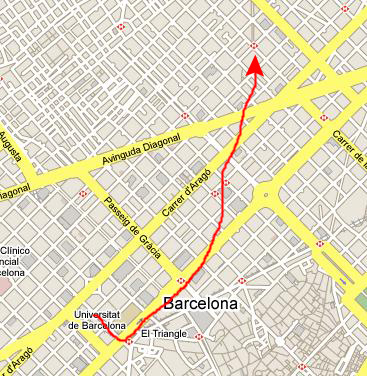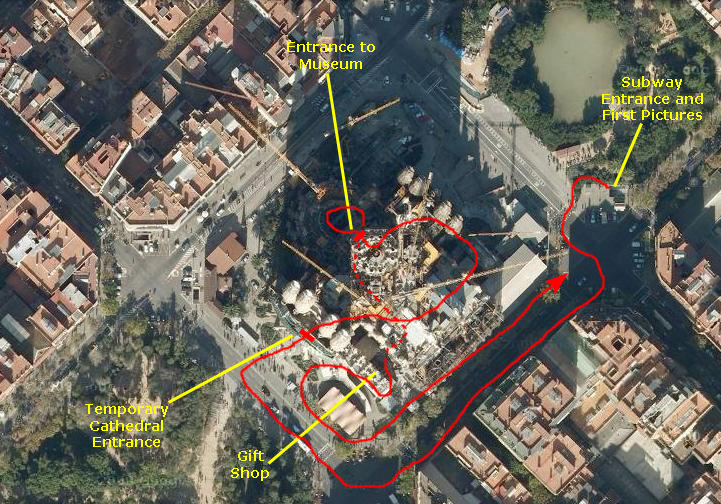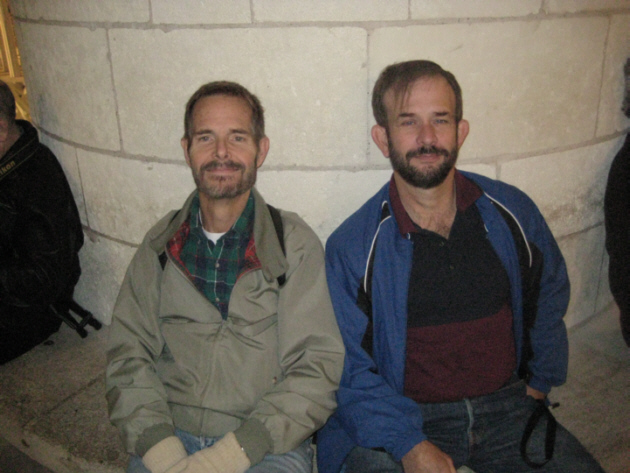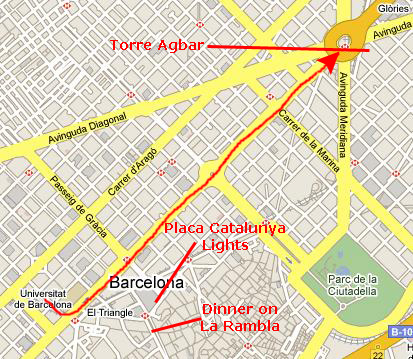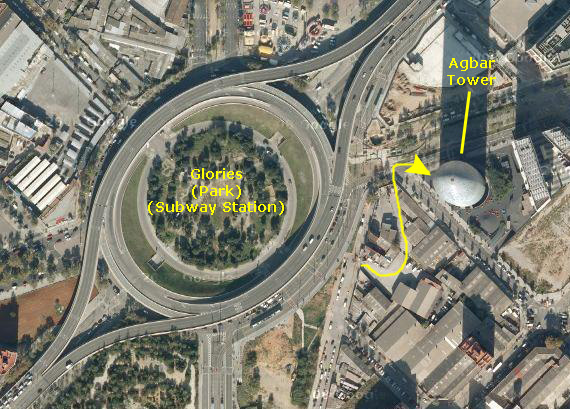 |
December 1, 2008: Barcelona (Day 4) and Sailing |
 |
November 29, 2008: Barcelona (Day 2) |
 |
Return to the Europe/Cruise Trip Index |
November 30, 2008
Barcelona, Spain
La Sagrada Familia
On Sunday, Greg, Fred, myself, John Toohey, John Lambert, Jason Swan and Barry Thomas all went out together to see some of the sights of Barcelona. The first stop was the Cathedral La Sagrada Familia. We took a great many pictures on this outing, so many that I have grouped them for easier viewing and explanation. In the four sections below you can follow us on our trip to this famous Barcelona landmark.
Getting to La Sagrada Familia
Getting to the Sagrada Familia Cathedral was pretty easy. All we had to do was walk down the street from the Axel Hotel, jump on the subway and ride to the Sagrada Familia station. Just after we'd gotten out tickets, I snapped a picture of John, John, Fred, Barry, Jason and Greg in the University subway station, and you can see that picture
here.
We headed on down to the
station platform
to wait for our train.
I've marked the approximate route that the subway line we took follows as it crosses northeast under downtown Barcelona to reach the area around Sagrada Familia.
Originally designed by Antoni Gaudí (1852–1926), who worked on the project for over 40 years, the project is scheduled to be completed in 2026. After Gaudí's death in 1926, work continued but was interrupted by the Spanish Civil War in 1936, during which time parts of the unfinished church and Gaudí's models and workshop were destroyed. The present design is based on reconstructed versions of the lost plans as well as on modern adaptations. Almost 3 million people visited the partially built church in 2008, making it one of the most popular attractions in Spain. The central nave vaulting was completed in 2000 and the main tasks since then have been the construction of the transept vaults and apse. As of 2006, work concentrates on the crossing and supporting structure for the main tower of Jesus Christ as well as the southern enclosure of the central nave which will become the Glory façade.
It was a quick, efficient ride, and about fifteen minutes later we came up aboveground at the corner of a one-block square park just across from the
Sagrada Familia.
You should be aware that the picture you just looked at is not actually a photograph of the cathedral, but rather an image taken from a poster in the park opposite the church showing what the finished cathedral will look like. The view of the cathedral on that poster is the one that people will have from the park where we were standing.
You may wish to refer back to this aerial view of the unfinished cathedral from the sections below. Our first stint of picture-taking was from the park where we came up out of the subway. We then walked along the southeast side of the cathedral and round to the southwest side. Here is where the temporary entrance to the cathedral is. It was very crowded here, with lots of tour buses and people getting tickets (not cheap at about $20/person). We took a good many more pictures here. Then we walked through the cathedral itself. The part of the red walking route between the little bars was actually inside the building. We came out on the northwest side, and it was here that we took a lot of pictures of the ornamentation (carvings) on that side of the cathedral. Then we walked around and down into the museum, which is actually underneath the cathedral. I've dotted the walking route line to indicate that we are below the building itself. The exit from the museum brings you up a ramp near the store and gift shop. From there, we went back out the entrance plaza and back around to the subway station.
La Sagrada Familia: Outside Views
Coming up out of the subway and facing this immense unfinished cathedral was pretty amazing. When the initial impression had worn off, we walked around the south side of the cathdral to get to the entrance plaza. Along the way, we took a couple of pictures that not only show the detail of the cathedral's outside faces, but also the extent to which the construction is ongoing. You should take a look at those pictures
here
and
here.
When we got around to the entrance plaza, we got more good picture opportunities from across the street, and we also took some close up after we'd bought our tickets and ascended the stairs to the temporary tour entrance. If you will click on the thumbnail images below, you can take a look at the pictures that we took here from the entrance:

I want to include some additional pictures of the outside of the Sagrada Familia taken from all different angles and from all different locations. Please click on the thumbnail images below to look at these pictures:

We also took some movies outside La Sagrada Familia, and you can use the movie players below to watch them:
|
In this movie, we are standing across the street from the church in the small park where we came up from the subway. This was our first look at the church itself. |
|
In this movie, we are standing across the street from the main entrance to La Sagrada Familia, look up at the spires and butresses on this side of the building. |
| In this movie, we have paid our admission and are standing just outside the main doors into the cathedral, looking up at the flying buttresses that are, presumably, helping to hold up the spires just above us. |
La Sagrada Familia: Outside Ornamentation
I have seen cathedrals before that I thought were very ornate on the outside, of course. Most Catholic churches, for example, seem much more ornate than the Protestant churches I grew up with. But La Sagrada Familia far outdoes anything I have ever seen for ornamentation. Almost the entire outside of the church (particularly on the northwestern side) is covered with carved figures and writings. Some entire scenes are carved into the outside of the building. The whole thing was way too ornate for my taste, but you be the judge by taking a look for yourself.
Below are three sections of thumbnail images. The first section presents a sampling of the kind of ornamentation that you can see on the outside of the cathedral. The second and third sections delve into the ornamentation in more detail, in some cases showing close-up views of some of what you saw in the first. There are lot of views here; click on as many of the images as you like to really get a feeling for how ornate (or even overly-ornate) is the outside of La Sagrada Familia:
Section One: Overview
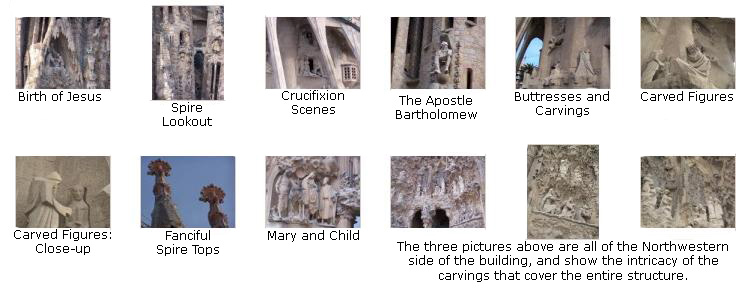
Section Two: Closeups and Detail

Section Three: Closeups and Detail

La Sagrada Familia: Inside the Cathedral
After we'd spent a good deal of time outside, we followed the indicated signs and went on inside the cathedral. The tour was on your own; there was no tour guide. There were plenty of explanatory materials along the walkway that wound all tthe way around the sanctuary. We had to pass up the line waiting to ascend into the spires as it would have taken most of the day, the line was so long. We opted for walking around in the interior of the catedral at our own speed. There was a service going on in the front of the cathedral, but there was a wooden wall between that area and the lines of people crowding through.
The most amazing thing about the inside of the cathedral were the
support columns
that were holding up the roof of the sanctuary. These columns looked like nothing so much as huge trees, with their "branches" spreading out as they ascended. It was hard for me to see how these columns that split into smaller, angled columns as they rose could actually hold the ceiling up. I couldn't understand how the gravitational load would be carried. But they do work, apparently, thought out by Gaudi using a process that we wouldn't learn about until we went through the museum.
But when you got to a vantage point near what will eventually be the main entrance, and look along
the length of the nave,
the geometry and the symmetry of the inside becomes quite inspiring. A forest of concrete is what it looked like to me. And here, in the inside, the paralaboloid columns are also decorated, though not with the kinds of carvings as we saw outside. Back by the main entrance there were a pair of
circular staircases
that also looked as if they were carved whole, or perhaps poured in a mold. Just before we left the inside of the cathedral, I got a picture of
Greg in La Sagrada Familia.
We took a good many other pictures here inside La Sagrada Familia, including some of the beautiful stained glass windows and other features of the interior. Click on the thumbnail images below to have a look at these pictures:
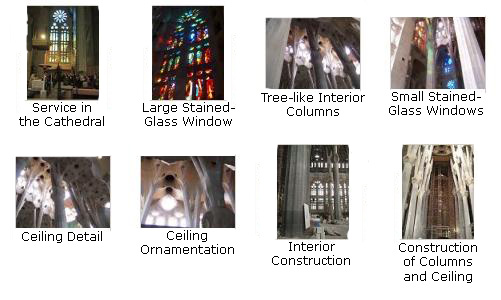
|
This movie will show you the 360-degree view of the current state of the interior of the La Sagrada Familia chapel. |
In the Museum Within La Sagrada Familia
Our last stop here was to visit the museum and bookstore, which are actually in the basement of the church.
To get into the museum, there is a circular ramp on the northwest side of the church that leads down to its entry. The ramp circles a small garden with a status of
Sant Josep Manyanet,
the "Inspirer" of this cathedral. He was canonized in 2004 by Pope John Paul II, and the sculpture is meant to be displayed on one of the windows of the cathedral.
There were a number of interesting exhibits inside the museum. On the wall just as you enter is a large copy of the
architectural plan
for the church. There were also a couple of models. One showed the
arrangement of columns,
and another model, so big you can
walk through it,
added in roof and ceiling detail.
One of the most interesting exhibits was a model of how Gaudi figured out loads and stresses for this and other buildings of his. He hung little bags of sand- hundreds of them- from chains and strings to see just how the strings and chains would form their arcs and arches. Then he simply inverted the model and built the columns to match. You can see the largest of these models
here.
When we left the museum, we stopped in the bookstore and some of us bought books or other items relating to the church. Then we left the church grounds and headed back to the subway station.
|
This movie shows the northwestern side of the building with all of the intricate carvings, and also pans around the area near the church to show you what the neighborhood is like. |
Casa Mila La Padrera
Our second stop today is an apartment building called Casa Mila La Padrera. This building was also constructed by Gaudi. This time, he got to indulge his ideas about apartment living, and the result is a unique building the is famous in architectural circles worldwide.
Getting to La Padrera
Getting to our next stop, the apartment building by Gaudi known as "La Padrera" or "Casa Mila," was very easy. All we had to do was take the subway back towards the Axel two stops.
When we came up aboveground, we were on Passeig de Gracia, just across the street from La Padrera. It was a little past lunchtime, so we went to a sandwich place just southeast of La Padrera, and then came back to get in line for our tickets. You can get guided tours, but using the audio tours was easier and less expensive. The apartment building is actually a residence, so the tour route uses only one elevator and one stairway. There is a museum/exhibit hall on the top floor as well as a model of what an apartment would have looked like when the building was first occupied. Then the audio tour led you up to the roof.
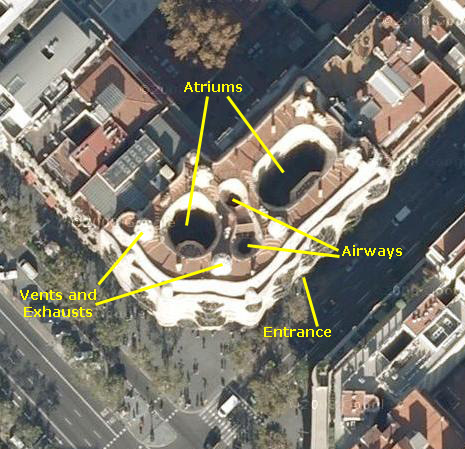 |
La Padrera occupies the southeast corner of one of the typical octagonal blocks so typical in Barcelona. It is right on the Passeig de Gracia- an upscale address in this city. Almost all apartments have balconies facing either the Passeig or the cross street; those that don't have balconies in the larger of the two atriums. These two atriums, which go all the way to the ground floor and are open to the sky, provide a great deal of light and fresh air to all apartments, and were designed to create a cross-ventilation so necessary before the advent of air-conditioning.
There are two other smaller air columns that bring fresh air to some of the apartments, and all apartments have access to one or more of the exhaust vents, the outlets of which on the roof are disguised as modernistic sculptures. All other mechanical equipment is similarly disguised, including the elevator housings. A series of walkways and steps have been built on the roof which has the appearance of a garden without plants. Residents have access and the tour brought us up here also.
Casa Mila La Padrera Outside and Atrium
As we approached the Casa Mila, Fred and I took some pictures of the entire structure, and we took some pictures in the larger of the two atriums after paying our entry fees and entering the building. If you will click on the thumbnail images below, you can look at these pictures:

|
This movie was taken just inside the lobby of the Casa Padrera, and shows how Gaudi designed the building so that all the apartments would have maximum access to natural light. The lobby was quite beautiful and ornate. |
The Exhibit Hall at La Padrera
The first part of the tour was through the exhibit hall. The elevator from the lobby took us right up to that floor (which happened to be the floor under the rooftop). In the exhibit hall were all kinds of things relating to La Padrera. There were scale models of the building, a floor plan, some exhibits on how Gaudi calculated stresses and supports, and even some of the furniture that Gaudi designed for residents of the building. The audio tour had us stop at each exhibit while it told us all about it. It was in the museum that I got separated from the other guys. My audio headset was defective, and by the time I had gone back down to the lobby to get a new one and returned to the museum, they had moved on. We didn't meet up again until we arrived back in the lobby.
Here are some thumbnail images for the best of the pictures I took in the museum. Click on the images to look at the pictures:

Exploring the Rooftop of Casa Mila
From the museum, we took the marked stairway that led to the rooftop. Here, we found a seemingly fanciful expanse of steps up and down and figures that were not quite chimneys and not quite statues. These shapes concealed air vents, chimneys and the like. The rooftop of Casa Mila was certainly the most interesting such place I have ever been, and we went a bit overboard, I guess, taking pictures here. Every view seemed unique, and we were snapping away. I want to include a lot of these pictures here, and I will have to separate them into categories.
Exhausts
One of the most numerous objects on the rooftop were the covers for the various exhausts from the bathrooms and kitchens of the building apartments. Each of these exhausts had a cover that to me looked something like a Muslim woman in her burkha.
These figures
were of various sizes depending on the size of the exhaust run, and some were standing alone and some were in clusters, again depending on just where the exhaust runs were. Some of the figures actually conceal stairways down into the building; I think there were only three or four of these. If you will click on some of the thumbnail images below, you can see full-size views of these figures:

Airways and Stairs
Some of the ornamental caps on the rooftop concealed stairways or larger air columns; these were typically at the corners of the rooftop. And, as you can see in the pictures below, the steps went up and around them. Also, some of the figures had a kind of dark tile mosaic top, rather than the beige "burkha" design; you can see some of these as well if you will click on the thumbnail images below:

Views of the Rooftop
Now that you've seen some of the individual examples of the various types of fanciful coverings that have been used on the La Padrera rooftop, we can pull back and look at some wider views of the rooftop itself. In these pictures, you can see the maze of steps and paths that wind their way up and down and around the rooftop, providing a neat place to stroll and walk (presumably the residents spend a fair amount of time up here). You can also see how these steps and paths wind around the two major atriums and also go alongside the edge of the rooftop. Click on the thumbnail images below to see some of these very interesting view of the La Padrera rooftop:

Views From the La Padrera Rooftop
While the rooftop itself was immensely interesting, the views from it were also pretty spectacular. Most buildings in Barcelona are no more than ten or so stories high. There are some office buildings that are taller, but there weren't many of them in the areas we toured. In some of the pictures below, you can see these taller structures sticking up above the general level of the buildings. Also in these pictures below, you can see some of the detail of what the interior of one of the octagonal blocks might look like. Click on the thumbnail images below and look at some of these pictures that we took from the roof of La Padrera:
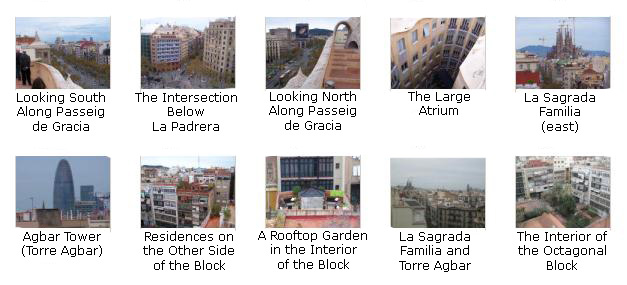
|
In this movie, you can come along with me as I walk up and down some of the stairs on the rooftop of La Padrera, and have a look at some of the fanciful "sculptures" up close. |
| Follow me as I walk along the edge of the La Padrera rooftop and look out over Barcelona in all directions. |
A Typical Apartment in Casa Mila (early 1900s)
Leaving the rooftop, we took the stairs down to continue our tour through a typical apartment in Casa Mila. The apartment was furnished as it might have been in the early twentieth century, and it was very interesting. There were lots of period pieces, such as this
old phonograph,
and there were lots of other old things as well. If you will click on the thumbnail images below, you can go with me on a tour of this apartment:
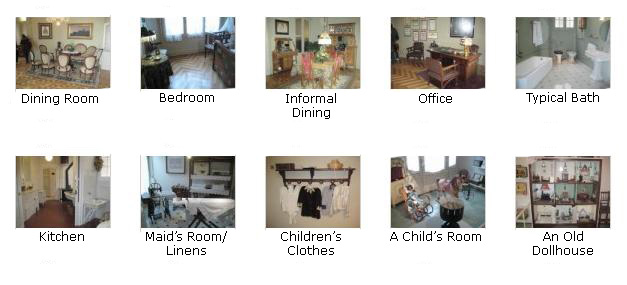
After the apartment tour, we all met up in the lobby once again, and then spent some time in the store/gift shop. Finally, since it was such a short distance back to the Axel Hotel, we decided to walk, taking our time on the way back.
Fred and I Take an Evening Excursion
After we'd spent some time at the hotel relaxing, Fred and I decided to go out and see some more of Barcelona at night. There wasn't a group dinner planned, so we thought we would just find a place ourselves.
The first thing we wanted to do was to find the Agbar Tower. This is a building that looks like a loaf of French bread stuck into the ground (or maybe the top part of a vibrator!). It is supposed to be quite spectacular at night. I actually forgot where we heard about it, although we'd seen it from the top of Casa Mila. We got some general directions and headed out.
We took the subway to the
Glories station
and came aboveground- a good ways east of the Axel Hotel.
When we came up, it was dark, of course, but we could see the Torre Agbar immediately off to our right- all lit up in blue and red. We also found that we were right beside a large, circular traffic interchange, and there were cars, busses and a trolley all using it.
We walked down the short street and took some stairs up to a main street; trolley tracks ran down the middle of it. We walked to the end of the block and the Torre Agbar was right in front of us. It was pretty spectacular, and we walked all the way around it a couple of times. There are pictures and a movie of it below, and Fred also took a picture of
me at the tower.
We wandered around the immediate area for a while, but it was pretty much a business area, or maybe residential, and we didn't see much in the way of restaurants and such. So we went back down into the subway and headed back to Plaza Catalunya.
Back in
Plaza Catalunya,
we headed over to La Rambla and found an inexpensive local restaurant that served all kinds of burrito-like sandwiches. It was really quite good, and all we wanted for dinner. After eating, we walked around the area for a bit. There were still quite a few people out, and most of the main streets had their Christmas lights up. You can see a couple of good examples of these decorations
here
and
here.
In addition to these pictures, we took some others while we were out this evening, and if you click on the thumbnail images below you can have a look at them:

|
In this movie, I begin at the base of Torre Agbar and pan up the entire height of the building. It's an excellent way to experience the color and the imposing nature of the building at night. |
| In this movie, you can walk along with us through the streets around Plaza Catalunya and enjoy the Christmas decorations. It was a beautiful night and a great time for an evening walk. |
When we were done walking around it was fairly late, so we headed back to the Axel Hotel to check email and meet up with the guys for a late drink in the bar.
You canuse the links below to go to another photo album page.
 |
December 1, 2008: Barcelona (Day 4) and Sailing |
 |
November 29, 2008: Barcelona (Day 2) |
 |
Return to the Europe/Cruise Trip Index |






